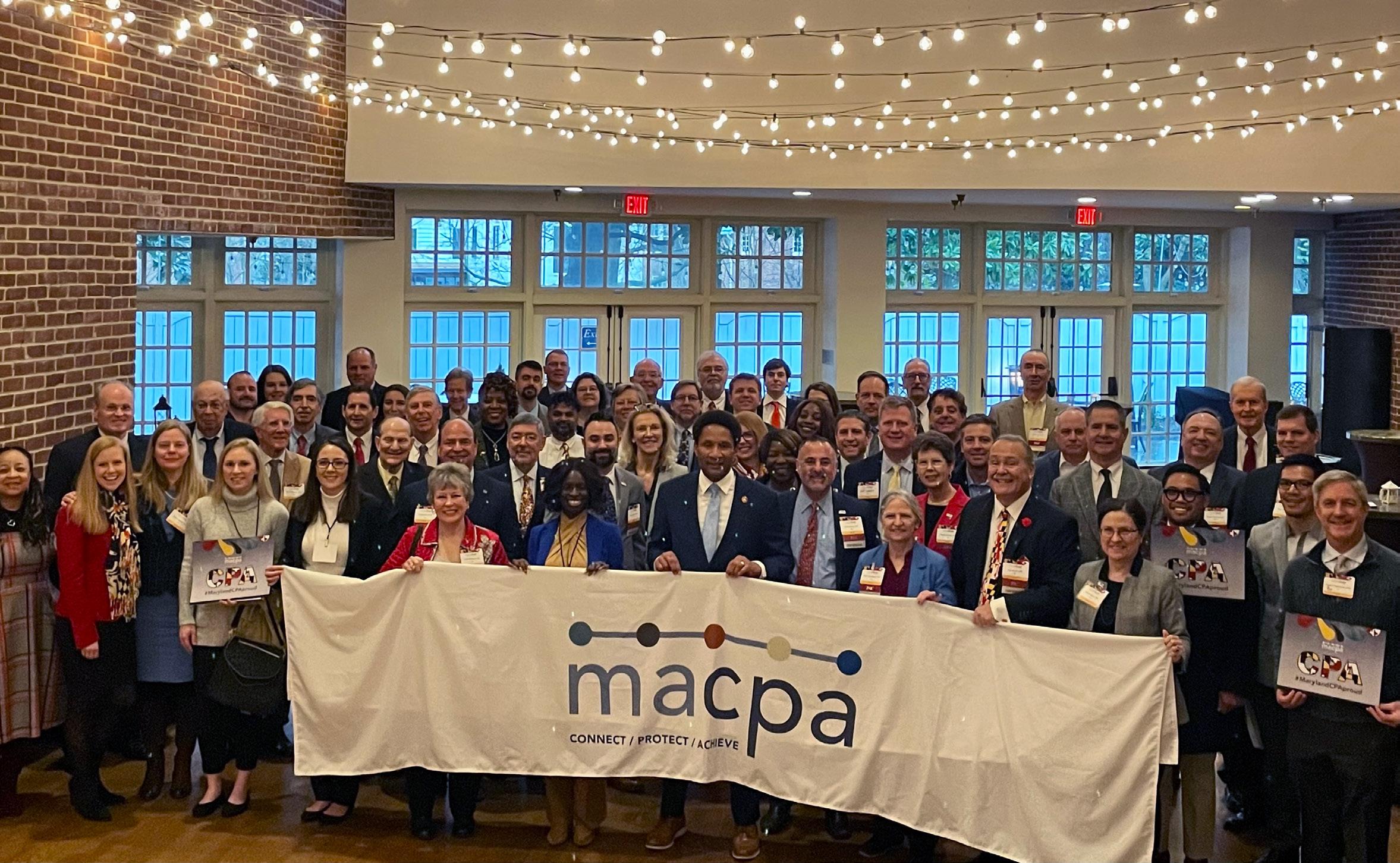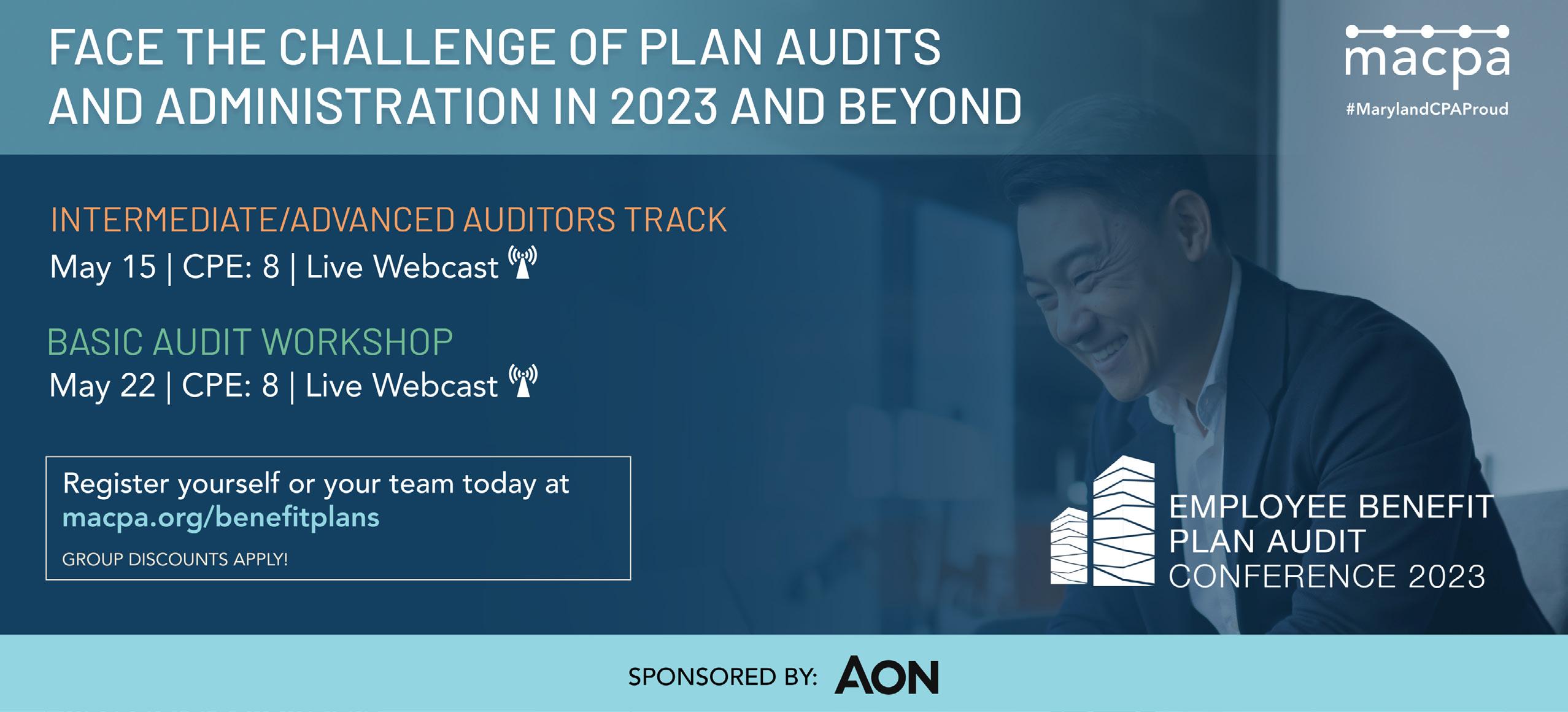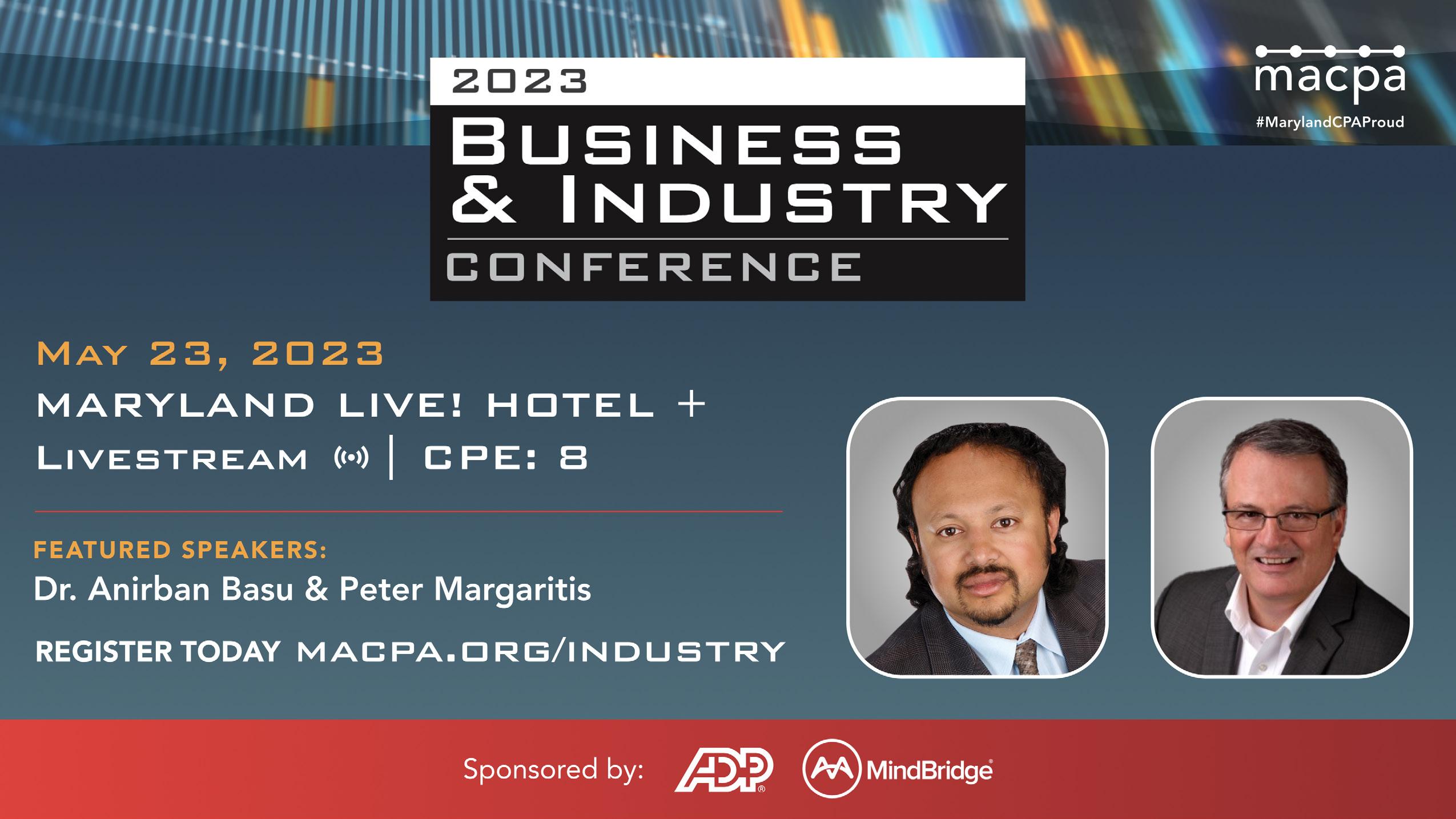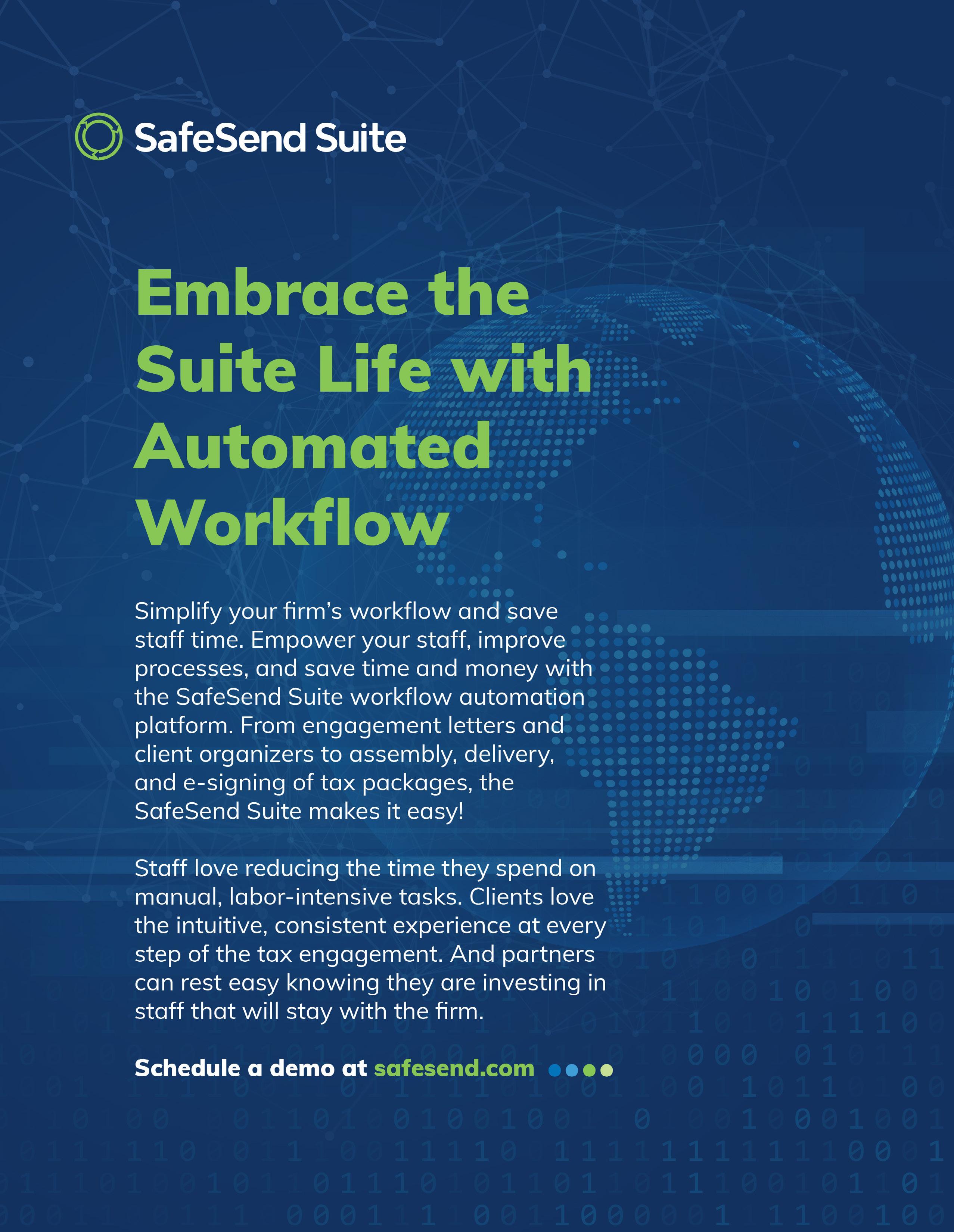
ALSO INSIDE
CPAs converge on Annapolis to help protect their profession
12
an exceptional client experience
24 STATEMENT WINTER 2023
Association of Certified Public Accountants, Inc. MEET OUR NEW COMPTROLLER BROOKE LIERMAN
4
Maryland
Page
Providing
Page
Maryland
PAGE

MEMBER SERVICES
Lauren Baker Sydney Glen
PEER REVIEW
Cora Edwards
PROFESSIONAL DEVELOPMENT
Natalie Antonakas
Kelly Brown
Chris Dougherty
Emily Trott
SPONSORSHIP / ADVERTISING SALES
Amy Puente
Krislyn Suljak
2022–2023 BOARD OF DIRECTORS
Herbert J. Geary III, CPA, CGMA Chair
Christine Aspell, CPA Vice Chair
Thomas White, CPA, CGMA Secretary/Treasurer
Lexy Kessler, CPA Immediate Past Chair
Karl Ahlrichs, SHRM-SCP, SPHR, CSP
Maxene M. Bardwell, CPA, CIGA, CIA, CFE, CISA, CITP, CRMA
Elise Brouillette, CPA
Michael Kimbrough, Ph.D., CPA
Kimberly Mustard, CPA, CGMA
Dave Ryan, Esq., CPA (retired)
Brett Sanders, CPA
Savedra N. Scott, CPA, CGMA, CrFAC, MSA, MBA
SENIOR STAFF
Rebekah Brown, CPA CEO
Skip Falatko, CPA CFO
Bill Sheridan, CAE CCO
Mary Beth Halpern Director Technical Services/ Regulatory Affairs
Dee Sullivan Director of Learning
1 WINTER 2023 CONTENTS CHAIR’S COLUMN ............................................................................. 2 FEATURES Brooke Lierman: An advocate for the people ...................................................... 4 Support our PAC … and strengthen the CPA’s voice in Annapolis .................... 10 Maryland CPAs converge on Annapolis to help protect their profession ......... 12 DEPARTMENTS News & Views ..................................................................................................... 15 Financial Planning ............................................................................................... 19 Public Practice ..................................................................................................... 24 Business and Industry 28 Tax Corner 32 High-Tech Solutions 36 From Our Partners 38 MEMBER NOTES ............................................................................... 44 CLASSIFIEDS.......................................................................................... 45 WINTER 2023 | Maryland Association of Certified Public Accountants, Inc. Bill Sheridan | MACPA Dulaney Center II 901 Dulaney Valley Road Suite 800 Towson, MD 21204 FOR CONTENT SUBMISSION: bill@macpa.org feedback@macpa.org TO ADVERTISE IN THE STATEMENT: krislyn@macpa.org P: 410.296.6250 F: 410.296.8713 Toll free: 800.782.2036 The MACPA reserves the right to edit all submissions for grammatical style and / or length. Statement of fact and opinion are made by the authors alone and do not imply an opinion on the part of the officers or members of MACPA. The Statement is published four times a year by the Maryland Association of Certified Public Accountants, Inc. Bill Sheridan, Editor Krislyn Suljak, Advertising Sales WE WANT TO HEAR FROM YOU! See below to submit content
CHAIR’S COLUMN
pipeline challenges
BY HERBERT J. GEARY III, CPA, CGMA / PARTNER, UHY LLP
When someone asks you why you chose accounting as a career, what do you say?
It’s an important question. If you’re speaking with a student who’s weighing their options, it could be a life-changing answer.
It’s an answer that could, in fact, help alter the future of our profession.
Ours isn’t the only profession feeling the pain of a constricting talent pipeline, of course, but that’s cold comfort at best. The pain is made worse by the fact that the shortage is driven by a number of factors, many of which — like declining birth rates, immigration policies, the rising costs of higher education, and a drop in the number of students seeking that education — are beyond our control. Other factors, though, are things that we might — in fact, should — be able to influence.
The MACPA Foundation, for instance, is laser focused on building a strong, diverse talent pipeline by providing training, granting scholarships, supporting DEI initiatives, and forging partnerships with organizations that will help us introduce our profession to the next generation of CPAs.

The MACPA is gathering information for potential comments on the National Association of State Boards of Accountancy’s proposed amendments to the Uniform Accountancy Act’s Model Rules. The proposal could ease the path into the profession by increasing the amount of time CPA candidates have to pass all parts of the CPA exam from 18 to 24 months.
In addition, the MACPA and its Foundation are focusing on a number of other areas where we can have an immediate impact, including:
• Collecting applications for our next round of student scholarships.
• Holding Student Leadership Academies for both lower and upperclassmen and community college students.
• Conducting visits to regional universities, community colleges, and high schools.
• Partnering with Junior Achievement chapters in Central Maryland, Greater Washington, and on the Eastern Shore.
• Producing a film aimed at sharing the varied and valuable opportunities that a career in accounting provides.
The AICPA also is joining the fight to strengthen our pipeline.
AICPA officials recently announced an “eight-point plan” of initiatives designed to address the root causes of our profession’s talent issues. Topping the list is an innovative education and experience program that could bridge the gap between 120 and 150 hours of education. Under this plan, students who graduate with a bachelor’s degree in accounting and immediately join a firm after graduation would do so as first-year associates. During that first year, they would be given time to take online courses and study — with appropriate competency assessments — as a way of earning their required 30 additional hours of education.
A pilot for this education and experience program will be announced this fall, and a broader release could take place as early as next year.
These types of initiatives are hugely important, but the work shouldn’t stop there. Sooner or later, this has to become a grassroots effort. That’s where you and I come in.
While the talent issue seems gargantuan, each CPA has a role to play, particularly when it comes to perception-based factors like the appeal of the profession, the number of hours we work, the types of work we do, and the diversity (or lack thereof) of career options.
That brings me back to my original question: When someone asks you why you chose accounting as a career, what do you say?
Too many of us don’t have an answer. We’ve long forgotten what first excited us about this incredible profession — the game-changing difference a trusted CPA can make for a business or client, or in the financial lives of Americans everywhere. We are the backbone of our nation’s financial future.
Too frequently, though, that purpose, that passion, that “Why?” has gotten lost. We need to find it, and share it — over and over again. We need to change the narrative that surrounds our profession. Each of us must shoulder some of the responsibility of exciting a new generation of CPAs. Here’s a sterling example of how that can happen.
The MACPA’s CEO, Rebekah Brown, recently shared a conversation she had with an intern at a local firm who explained why he decided to go into accounting. He said he loves solving complex problems for his clients so that his clients, in turn, can solve complex problems for their communities. He looks at his firm’s clients and sees, for example, a not-for-profit organization that received a grant because of the work he did on their behalf. He sees that client take that grant and use it to improve the lives of others. He sees people leading better lives because of the work he does.
How’s that for an answer? If students heard more of those types of stories, our pipeline would fill in a hurry.
That’s my challenge for you: Rediscover your passion for this profession. Turn it into a story. Then contact the MACPA to find out how you can share that story in a meaningful way. We’ll help you make that difference.
Too many of us keep hoping somebody else will solve our talent issues.
The answer, in fact, might lie within each of us.
STATEMENT 2
We each have a role to play in solving our
Ignition’s ultimate year-end resource hub
Fuel your practice growth in 2023 with our collection of year-end resources for accountants & bookkeepers. The resource hub features howto-guides, on-demand webinars, downloadable checklists and more! Scan the QR code to access the resource hub.

You’ll learn how to:
Boost practice efficiency
Position your firm for scalability
Strategically price your services
Improve your client communications

Ignition brings everything you need to engage clients seamlessly, get paid effortlessly and run your business on autopilot in one place. Visit ignitionapp.com
Trusted by 6000+ accounting and professional services businesses globally
2M+ Proposals accepted with Ignition
$3B+ Client payments processed
1M+ Clients engaged
3 WINTER 2023
BROOKE LIERMAN

‘AN ADVOCATE FOR THE PEO PLE’
New Maryland Comptroller Brooke Lierman seeks a partnership with CPAs and a government that works for all taxpayers and businesses
BY BILL SHERIDAN, CAE
It’s a year of legislative change in Annapolis, and nowhere is that more obvious than in Maryland’s Comptroller’s Office.
After four terms as the state’s top accountant, Peter Franchot has vacated the office he held since 2006. Franchot chose not to seek a fifth term and instead joined a crowded Democratic field in the 2022 race for governor. He finished third in the Democratic primary.
Franchot’s departure brings a 36-year public service career to an end; he served Montgomery County in Maryland’s House of Delegates from 1986 to 2006.
It also opens the door for Maryland’s first new comptroller in nearly a generation, and a history-making one at that.
Brooke Lierman, a Democratic state delegate representing Baltimore City, defeated Harford County Executive Barry Glassman in November to become the first woman to be elected Maryland’s comptroller.
Lierman has said her role is “about partnership, not partisanship,” and she has already demonstrated that belief with Maryland’s CPAs. In 2022, she sponsored a House bill that called for the establishment of a Legal Division in the Office of the Comptroller and the creation of a private letter ruling process.
Private letter rulings, or PLRs, allow taxpayers to get binding answers from the Comptroller’s Office to their tax questions. In turn, the taxpayers can then pay the right amount of tax at the right
time, rather than years later after an audit or litigation. Several dozen other state departments of revenue have a similar process in place, and MACPA legislative volunteers have advocated for a private letter ruling process for some time. By establishing a Legal Division in the Office of the Comptroller and creating the PLR process, Maryland has taken a strong step in the fair and transparent administration of state tax laws.
Lierman said the PLR process is “essential both as a service to taxpayers and as a compliance tool,” and her support was key to passing a piece of legislation that Maryland’s CPAs have sought for years. MACPA members — and undoubtedly Lierman herself — will be counting on that level of cooperation and collaboration repeating itself throughout her term.
Lierman sat down recently for an interview with Statement Editor Bill Sheridan to discuss the opportunities that lie ahead for her office, the relationship between the Comptroller’s Office and the state’s CPAs, and the future of revenue administration in Maryland – and how CPAs fit into that vision.
Q&A
Here’s what she had to say.
Comptroller Lierman, thank you so much for joining me. How has the transition been progressing?
It has been a whirlwind. We hit the ground running after election day. We have named the leadership team, and we are
working to prepare for meetings to go over the many aspects of the Comptroller’s Office, which is a vast office and tackles so many different areas of our state financial systems. So I’m really excited. There’s a lot to do.
Why this role for you? What was it about the Comptroller’s Office that drew you in?
From my time in the General Assembly serving on the Appropriations Committee and as co-chair of the Oversight Committee on Pensions, I came to know, understand and appreciate just how uniquely situated the Maryland Comptroller’s office is to make a difference on economic matters — to build financially resilient communities, to make Maryland a great place to do business, and to make government work better for people.
Most people, when they interact with the government, often it is through the Comptroller’s Office. I want to make it work well for people because that, in turn, can help them succeed and to become more financially resilient. I’m so excited about the fact that the Comptroller’s Office touches such a huge percentage of Marylanders and Maryland businesses. I want to be there as an advocate for the people, and I think this is the place to do it.
What have you seen in the Comptroller’s Office that’s (a) working well, and (b) might need some improving?
I think our people are our strength. We have incredibly dedicated staff who
5 WINTER 2023 CONTINUED ON PAGE 6
CONTINUED FROM PAGE 5
are mission-driven, who are focused on making sure that we can get the job done for Marylanders, that we can collect revenue but also work with families and businesses and taxpayers to ensure that things are going well for them and that the process is smooth.
a result of legislation that I brought and helped pass last year. This is something that nearly every other state offers, and it’s an incredibly important service to let people know how our tax laws affect them and how their situation applies to our tax laws. I’m really excited to get that up and
I’m glad you mentioned the Legal Division. That’s something that the MACPA and CPAs in general have been eager to see for a while now. What kind of changes can we expect to see not only for taxpayers but tax professionals as a result of the Legal Division taking form?
One of the things that’s obvious to almost everybody is how outdated our technology is. That results in so much more work for customers, constituents, for Marylanders and Maryland businesses, but it also creates so much more work for the people in the Comptroller’s Office in terms of updating forms and answering phone calls. We don’t have a clear, modern IT system set up for people to use, and that creates more work for everybody. I’ve started learning about the work that we’re doing to create and implement a new IT system for revenue administration, but we have a ways to go. It’s a slow and painstaking process to get it done, but people are working diligently on it.
I’ve loved meeting our people. I’m meeting more people every day to hear about what they think we need to make sure that we can fulfill the mission of the Comptroller’s Office.
What future opportunities do you see — things you’d like to implement or new ideas?
One of the things I’m excited about is the fact that we are creating an Office of Legal Division in the Comptroller’s Office and will finally be able to do private letter rulings in the state of Maryland —
running and make sure it’s staffed properly so we can do that important work.
I’m also really excited about rethinking the Comptroller’s website to make it more user friendly — to make sure that Maryland taxpayers and business owners can go to the Comptroller’s website and get everything they need.
We’re also thinking through a lot of other ideas as well. The Board of Public Works has been thinking about sustainable investing and making sure that we’re meeting our goals on the pension side. It comes down to making sure we’re fulfilling our duty to think long term for our pensioners and taking climate risk into account to ensure that we have responsible investing by our state retirement and pension board. And there are many other things. I’m excited to work to beef up the Ombudsman’s Office and have Taxpayer Services advocate like the IRS and many other states have.
There are a lot of possibilities, but we have to start where we are. We have a great team and we will continue building that team so we can do a lot of this work for Marylanders.
My hope is that once it’s up and running and fully staffed, it’ll be a partnership. You will have a partner in the Comptroller’s Office who can work with the MACPA and tax attorneys to solve some of the ongoing questions that exist so that your clients can know what they owe and pay what they owe. We’d really like to work with Maryland’s CPAs to help solve recurring questions that come up over and over again. We need definite answers to those questions so we don’t have to keep asking over and over, and researching over and over. We’d like to understand what those questions are so we can get them answered quickly, publish those opinions, and have them located in a place where people who need them have access to them.
It’s going to be hugely important that we partner with the MACPA and our tax attorneys through the Office of Legal Division, and that we’re staffing it with people who are excited to be partners and to work with you on that work. We are mission driven, and making sure we’re sharing that mission and working together is important to the success of the agency — and to MACPA’s success as well.
You’re part of a completely overhauled board of Public Works. Maryland’s highest administrative body, made up of the governor, the treasurer, and the comptroller, and you’re all fairly new to your jobs now. What’s that dynamic like? What’s it like to be coming into a situation like that?
It’s really exciting. I’m excited to serve with Treasurer (Dereck) Davis, who I served with in the General Assembly. And I’m thrilled to be sitting next to Gov. (Wes) Moore. We are all excited to work together, and I think we all understand just how important the Board of Public Works is not just to the future infrastructure of the state, but to Maryland’s future economy. The Board
STATEMENT 6
“
If we’re focusing on revenue administration and taxes and authority, I want Maryland to be at the top of the country.
of Public Works is not just about laying pavement. It’s about building communities and community wealth and a more financially resilient economy in Maryland.
I’m excited to work with my BPW colleagues to make sure we are examining those contracts, that they fulfill those missions, and that we’re working with our contractors going forward to make sure there’s accountability and transparency so we know that our money is being spent in a way that’s building a stronger economy, building buildings and laying broadband, and working in our wetlands. There’s so much that we can do from the Board of Public Works. I’m really excited about it.
With that vision in mind, what’s your philosophy on evaluating spending decisions at that level? What kind of criteria do you apply as you’re considering where the money goes?
That’s a great question. I actually practice procurement law and I have represented small businesses across the country in both federal and state procurement matters. Often what happens is that rather than securing the best value for our tax sellers, people go for the lowest cost. Almost inevitably, when you buy the lowest cost, they put change order after change order after change order in — so it ends up not being the lowest cost at the end, and you’re not getting the value you want. What we should be looking for is best value. Are we creating jobs in Maryland? Are we creating wealth in Maryland? Are we working and meeting our goals? Is this a contract for a new public building that’s going to be located in a floodplain? Let’s think through how we’re spending our dollars and where those dollars are going so we don’t have to retrofit everything in 10 years.
It’s about thinking through some of those basic questions and making sure that rubric and framework is applied to the contracts that come to the Board of Public Works. It’s my goal that every agency and group that comes to the Board of Public Works gets that and are fully implementing that.
It doesn’t always work like that, unfortunately, so we are going to need to
work upstream to make sure the agencies understand that this is the mission. We’re going to have to identify the barriers to implementing that vision. Are they statutory? Are they regulatory? Or is this just a bad tradition that we need to let go? We need to have people in the Comptroller’s Office and on the Board of Public Works who can work to help pinpoint some of those challenges and barriers.
What’s the ideal relationship between the Comptroller’s Office and the state’s CPAs? What kind of help do you need from our profession?
There has to be a partnership. There has to be an open door so we can talk with the MACPA, its members, and tax attorneys about the challenges their clients are seeing and the challenges they’re seeing in the Comptroller’s Office. Likewise, the comptroller has to be open with MACPA members, accountants, and tax attorneys about some of the limitations we have right now because of our outdated technology. And we might have to brainstorm and come up with workarounds until we fully implement Compass (the Comptroller’s Office’s new tax processing system), making sure we’re keeping the CPAs and tax attorneys up to date on how things are going.
I think it’s about having a give-and-take and talking openly and being trusted partners about how we can make sure Marylanders are able to pay their taxes in the correct amount and on time, and that
they’re able to get their refunds timely. Also, it will always be the job of the comptroller to go after fraudulent behavior. If you hire an accountant or a tax attorney, I think that indicates you’re trying to do the right thing, generally, and pay the proper amount. But there will always be a group of companies and people out there who are looking for ways to not pay what they owe. It’s essential that the comptroller has a strong fraud detection unit, and we do. There’s always more to do, though, in terms of modernizing and thinking through what new technology exists to help find some of the unpaid taxes.We saw a great amount of fraud throughout the pandemic — not necessarily tax fraud, but other kinds of fraud. So there’s a lot of work to do, and I hope that as they see some of that type of behavior, CPAs and tax attorneys will bring it to the attention of the Comptroller’s Office. Certainly, the Comptroller’s Office needs to say to tax attorneys and CPAs, “Heads up: We are starting to see this type of fraudulent behavior. Please keep your eyes out for it.” That’s what a partnership looks like, and having those kinds of regular and ongoing conversations is important.
What does the future of this office look like to you? Where would you like to take it going forward?
If we’re focusing on revenue administration and taxes and authority, I want Maryland to be at the top of the country. I want people to get their refunds quickly, but more importantly, I want people to be
CONTINUED ON PAGE 8
7 WINTER 2023
It’s about building communities and community wealth and a more financially resilient economy in Maryland.
“
CONTINUED FROM PAGE 7
able to pay their taxes in a quick, easy, and efficient way and claim all the tax credits they’re entitled to and know about them. Too many people don’t know that they should be claiming the Earned Income Tax Credit, for example. We just passed a senior tax credit last year in the General Assembly, and many seniors are not going to know about that credit, or how to claim it. I want Maryland to be the place where people get their tax credits, they know about them, it’s easy to pay your taxes, and you get great customer service when you have questions.
I want it to be easy to start a small business in Maryland, and for the tax infrastructure in Maryland to be easy for taxpayers and businesses to deal with. I want Maryland government to work the best it possibly can for all taxpayers and small businesses
— for businesses and families and nonprofits alike. Nothing’s ever going to be perfect, in business or in government. But when there are challenges, I want people to think, “When I call the Comptroller’s Office, they’re able to help me. They can pinpoint my problems, and they can help close loopholes and get things done for people.” That’s my goal for our revenue administration activities and for all of the work we’re doing around taxes.
I’m so excited to work with people around the state. I loved running (our campaign) statewide. I love talking with people about what the Comptroller’s Office does, empowering them with information and hearing from them about what works, what doesn’t, their ideas for how the comptroller can help.
And I’m excited to keep doing that work. It’s just so important for our comptroller — and for all of our public officials — to make themselves available to the public, so people understand what these government roles are and how they can work in their communities. I’m excited to keep doing that while also working to make sure that we are thinking through how we can modernize the structure of the Comptroller’s Office so it’s best serving the people of Maryland.
Bill
Sheridan, CAE, is editor of The Statement and chief communications officer for the MACPA.


9 WINTER 2023 Put a leader to work for you Serve a wide range of clients, with over 5,700 forms and more than 25,000 error diagnostics for strong accuracy. Power up your productivity Tap into 32 built-in timesavers that help pros like you save an average of 46 minutes on every complex return.* Gain cloud advantages Get built-in layers of security, automatic backups and updates, and strong IT support with Hosting backed by Intuit.* Visit IntuitAccountants.com/TryLacerte2022 to explore more and try it free. Or call 833-239-4893 to get your custom recommendation in minutes. *See important notes: Time savings based on an Intuit study of tax professionals who primarily used Lacerte software in tax year 2020. Hosting for Lacerte is a monthly subscription. Additional terms, conditions, limitations, and fees may apply. Tackle even the toughest returns confidently, with the powerful tools and cloud advantages of Intuit Lacerte Tax on your side.* I rely on Lacerte to take care of any tax scenario, so my clients always know I take care of them
Maryland Political Action Committee

and strengthen the CPA’s voice in Annapolis
Maryland’s General Assembly meets in Annapolis each year and votes on critical issues that impact your profession, your livelihood, and the businesses you serve.
That’s why we urge you to support the CPA Committee on Political Action. The CPA/ CPA is the only political action committee in Maryland dedicated solely to fighting for CPAs in the legislative arena.
Good relationships with legislators are the core of the MACPA’s legislative advocacy efforts. Your contribution to the CPA/CPA is one of the easiest and most effective ways for CPAs to get involved in the political process and have an impact on the profession.
Contributions to our PAC lag far behind other professional groups. This puts us at
a severe disadvantage, especially when certain groups have interests opposed to ours and have far greater PAC participation from their members.
Through contributions from members like you, the PAC works toward favorable outcomes on legislative issues, educates legislators about matters that are important to the CPA profession, and keeps MACPA members informed. But we can’t do it alone. Your involvement makes a difference and ensures that, together, we make the greatest impact.
Your contribution to the CPA/CPA will allow us to support legislators from both parties, and help the CPA profession maintain an influential presence in Annapolis. Thanks so much for your support!
10
Support our PAC … FROM BILL SHERIDAN, CAE PLEASE SUPPORT THE MACPA’S CPA/CPA TODAY donate online at macpa.org/advocacy Or scan the QR code at the left.


WINTER 2023
SUPPORT OUR PROFESSION AT THE POLICY LEVEL. Donate Now: macpa.org/give-PAC
The PAC works toward progressive outcomes on legislative issues affecting CPAs, educates legislators about matters that are important to the CPA profession, and keeps MACPA members informed. Your contribution will help ensure Maryland CPAs have influence in Annapolis and build a vibrant future for the CPA profession. P OLITICAL A CTION C OMMITTEE Give Our Profession a VOICE
Maryland CPAs converge on Annapolis
CPA Day returns to in-person format after two years after pandemic-related virtual meetings
FROM BILL SHERIDAN, CAE
ANNAPOLIS — In a year when so much feels new in Maryland’s capital, the MACPA fell back on an old, familiar routine Jan. 19 when more than 100 CPAs and legislative volunteers turned out for the return of a live, in-person CPA Day in Annapolis. Held virtually each of the past two years due to the pandemic, the event gave members an opportunity to meet in
person with their state legislators and discuss issues that impact Maryland CPAs and those with whom they do business. And the return of the in-person format was welcomed warmly by those in attendance.
“It was wonderful to gather in person in Annapolis once again for our most important event of the year,” said MACPA Executive Director Rebekah

Brown. “Nothing can beat the power of a live, in-person meeting with our elected officials, except maybe the electricity that’s generated by a room full of energized, focused CPAs. It was great to feel that energy once again. “
The in-person event was followed a day later by a virtual followup session in which nearly 250 members joined MACPA
STATEMENT 12
leaders online to hear updates from Annapolis as Maryland’s 445th General Assembly rolled into action.
The live event on Jan. 19, though, was all about re-establishing connections between the state’s CPAs and lawmakers and celebrating the arrival of new legislative leadership. Annapolis was
still abuzz from the inaugurations of new Gov. Wes Moore and Comptroller Brooke Lierman (see page 4), who join state Treasurer Dereck Davis on a completely revamped Board of Public Works.
In addition, eight senators and 40 delegates were elected in November and many of the chairs of key legislative
WHAT DOES ALL OF THAT MEAN?
committees are new to their posts. They include Sen. Brian Feldman, a Democrat representing District 15 in Montgomery County and one of just three CPAs in the General Assembly, who has been chosen by Senate President Bill Ferguson to chair the Senate’s Committee on Education, Energy, and the Environment.
Simply put, it means a lot of work for the MACPA’s advocacy volunteers. The association put a lot of time and effort into building fruitful relationships with the General Assembly’s departing leaders and now must start fresh with new leadership in these areas. That takes time, effort, and CPAs who know these new leaders and can rebuild those relationships from the ground up.
That work will be ongoing. More urgent, though, is the MACPA’s 2023 legislative agenda.
IT INCLUDES FOUR KEY ISSUES:
Opposing sales taxes on professional services, including those provided by CPAs .
Opposing efforts to replace Maryland’s contributory negligence standard with a comparative fault rule. Comparative fault is a legal maneuver that would result in increased costs of doing business and decreased produ ctivity.
Supporting a properly funded budget that will allow the Comptroller’s Office to retain its current team as well as hire additional qualified personnel by offering competitive salary levels, and also allow for a more modern IT system for efficiency of the agency’s tax administration operations.
Encouraging lawmakers to follow the guiding principles of good tax policy when considering legislation related to the legalization of recreational adult-use cannabis, which was approved by voters in November.
13 WINTER 2023

STATEMENT 14
13 MACPA members, partners named among profession’s most influential people
FROM BILL SHERIDAN, CAE
The MACPA’s influence on the accounting and finance profession continues to grow. No fewer than 13 MACPA employees, members, and strategic partners — including new MACPA CEO Rebekah Brown — have been included on Accounting Today’s 2022 list of “The Top 100 Most Influential People in Accounting.”
“I’m honored and humbled to be included on this prestigious list, and I’m beyond proud that MACPA members and partners continue to be recognized for their immeasurable influence on the profession at large,” said Brown. “These people aren’t just colleagues. They’re friends and thought leaders, and they are helping to lead our profession forward into an exciting, promising future.”
OF BROWN, ACCOUNTING TODAY WRITES THE FOLLOWING:
“The Maryland Association of CPAs has long since established itself as one of the most forward-looking of state societies, and Brown played a high-profile role in building the national platform from which she will now have an outsized influence on the future of the profession.”
Former MACPA CEO Tom Hood, now the executive vice president of business engagement and growth at the Association of International Certified Professional Accountants, has once again been named the second most influential person in the profession, one position behind AICPA CEO Barry Melancon.
And Kimberly Ellison-Taylor — former chair of the MACPA, the American Institute of CPAs, and the Association of International Certified Professional Accountants boards of directors — has been named the fourth most influential person in the profession.
OTHER MACPA MEMBERS AND PARTNERS ON THIS YEAR’S TOP 100 LIST ARE:
• Erik Asgeirsson, CEO and president of CPA.com, an MACPA Preferred Provider.
• Kim Austin, director of global strategic accounting partnerships with Avalara, an MACPA Preferred Provider.
• Wayne Berson, CEO of BDO USA and an MACPA member.
• Kacee Johnson, vice president of strategy and innovation with CPA.com, an MACPA Preferred Provider.
• Edward Karl, vice president of tax policy and advocacy with the AICPA and an MACPA member.
• Ed Kless, a Meta consultant with Sage, an MACPA Preferred Provider.
• Rene Lacerte, CEO and founder of Bill, an MACPA Preferred Provider.
• Anoop Mehta, chair of the AICPA Board of Directors and former chair of the MACPA Board of Directors.
• Jody Padar, vice president of tax strategy and evangelism at April and an MACPA member.
• Scott Peterson, vice president of U.S. tax policy and government relations with Avalara, an MACPA Preferred Provider.
“We are incredibly proud to see this many MACPA connections standing out in a profession that includes more than half a million CPAs in the United States,” Brown said. “Each of them understands that with great influence comes great responsibility — one we take seriously in our efforts to connect, protect, and help a CPA-led profession achieve success. Our heartfelt congratulations go out to each of them.”
Bill Sheridan, CAE, is editor of The Statement and chief communications officer for the MACPA.
15 WINTER 2023
NEWS
& VIEWS
CPA Brian Feldman picked to lead Maryland Senate’s Committee on Education, Energy, and the Environment
FROM BILL SHERIDAN, CAE
ANNAPOLIS — A year of change in Maryland’s General Assembly is ending with even more changes at the legislature’s highest levels, and this time a CPA is in the spotlight.

Sen. Brian Feldman, a Democrat representing District 15 in Montgomery County and one of just three CPAs in the General Assembly, has been chosen by Senate President Bill Ferguson to chair the Senate’s Committee on Education, Energy, and the Environment. Previously named the Senate Education, Health, and Environmental Affairs Committee, Feldman’s committee “will handle all energy and utilities-related legislation to develop policies that reflect the intersection of energy and utilities policy with environment and climate change policies,” according to CBS Baltimore. The committee also will oversee the licensing and regulation of Maryland businesses.
As committee chair, Feldman succeeds Sen. Paul Pinsky, who has been picked by Gov.-elect Wes Moore to lead the Maryland Energy Administration.
A longtime legislative friend of the accounting and finance profession and the MACPA, Feldman had most recently served as vice chair of the Senate Finance Committee. He has served as a member of the Senate since 2013. Before that, he served as a member of Maryland’s House of Delegates from 2003 to 2013.
“I look forward to the steady leadership that Sen. Feldman will undoubtedly bring to the newly configured EEE committee,” Ferguson said. “As the vice chair of the Senate Finance Committee, Sen. Feldman has demonstrated the ability to lead on complex legislation and work across the aisle.”
“We’re so proud to see a member of our profession take on such a prominent leadership role in our state’s legislature,”
MACPA CEO Rebekah Brown added. “As a CPA, Sen. Feldman has the experience and foresight necessary to lead the Senate’s Committee on Education, Energy, and the Environment, and we look forward to continue working with him on important matters that impact our members, our business community, and Maryland at large.”
A second CPA and MACPA member, Sen. Arthur Ellis, a Democrat representing the 28th District in Charles County, has been appointed by Ferguson to serve on the Senate Finance Committee.
A complete list of Ferguson’s Senate committee assignments is found on the Maryland Matters website (bit.ly/ MDappointments).
Bill Sheridan, CAE, is editor of The Statement and chief communications officer with the MACPA.
NEWS & VIEWS

17 WINTER 2023 A global leader in financial risk discovery and anomaly detection www.mindbridge.ai Crossover to clarity



STATEMENT 18 We are with you for the moments that matter most. We help mitigate risk, so you can enjoy peace-of-mind. AICPA Member Insurance Programs provides CPA firms with exclusive access to risk and insurance solutions that help safeguard your livelihood and lifestyle, including our renowned AICPA Professional Liability Program. Our comprehensive plans help keep your firm and your employees secure, and help your business run smoothly in the moments that matter most, so you can focus on your clients and achieving your goals. To learn more, please call Robert Albertini or Candace Coach at Aon Insurance Services at 800.221.3023 to speak with an AICPA Risk Advisor or visit cpai.com/moments Aon Insurance Services is the brand name for the brokerage and program administration operations of Affinity Insurance Services, Inc., a licensed producer in all states (TX 13695); (AR 100106022); in CA & MN, AIS Affinity Insurance Agency, Inc. (CA 0795465); in OK, AIS Affinity Insurance Services Inc.; in CA, Aon Affinity Insurance Services, Inc. (CA 0G94493), Aon Direct Insurance Administrators and Berkely Insurance Agency and in NY, AIS Affinity Insurance Agency. One or more of the CNA companies provide the products and/or services described. The information is intended to present a general overview for illustrative purposes only. It is not intended to constitute a binding contract. Please remember that only the relevant insurance policy can provide the actual terms, coverages, amounts, conditions and exclusions for an insured. All products and services may not be available in all states and may be subject to change without notice. CNA is a registered trademark of CNA Financial Corporation. Certain CNA Financial Corporation subsidiaries use the “CNA” trademark in connection with insurance underwriting and claims activities. Copyright © 2023 CNA. All rights reserved. E-14217-123 MD 66% of AICPA’s 400,000+ members insured 23,000+ firms insured 75+ years serving the profession Plans for Firms Professional Liability Employment Practices Liability Cyber Liability Business Overhead Expense Commercial Property & Liability Group Identity Theft Group Life & Disability Group Personal Excess Liability Specialty Coverage Brought to you by
Give your employees free, easy access to retirement plans with MarylandSaves
FROM BILL SHERIDAN, CAE
Retirement may come as a painful shock to far too many Americans.
About 25% of U.S. workers have no retirement savings and only 36% believe their retirement plan is on track, according to PwC’s “Retirement in America” report. Among those with no savings at all are 13% of those age 60 and above and 17% of those between the ages of 45 and 59. Our oldest workers — those who, presumably, have been saving the longest — have a medium retirement savings account balance of just $120,000. “When divided over 15 years,” Yahoo! Money reporter Stephanie Asymkos writes, “that would generate a modest distribution of less than $1,000 per month and even less for those who outlive their life expectancies.”

It’s a problem that impacts us all. Local and state governments will shoulder an outsized share of the financial burden when it comes to supporting those with no savings — and you and I will be forced to chip in.
But in Maryland and a handful of other states, help is one the way.
A new program called MarylandSaves was launched on Sept. 15 to make it easy for employers to provide workers with access to a retirement plan — a critical first step in boosting the retirement savings of employees throughout Maryland.
“The idea is to make it as easy as possible for employers who don’t already have a retirement plan to offer a state-sponsored plan to their employees,” said Glenn Simmons, acting executive director of the Maryland Small Business Retirement Savings Program. “Our charge was to come up with a plan that is free and as easy as possible for employers to implement.”
MarylandSaves is the by-product of a law that was passed in 2016 by the state’s
General Assembly. The law mandates the employers in Maryland who pay their employees with an automated payroll system or service must offer their employees access to a retirement plan. When its program was launched in September, Maryland became just the fifth state to enact what Simmons called a “state-sponsored auto-IRA program.” Oregon led the way in 2017, followed by Illinois, California and Connecticut.
“When people reach retirement age and can’t work anymore, that causes a huge strain on social services — Medicare and Medicaid, but others well beyond that,” Simmons said. “Some people seem to think they can live on Social Security alone, but Social Security was never designed to be a full retirement vehicle.”
MARYLANDSAVES: HOW IT WORKS
The program is mandatory for Maryland employers. While other states encourage participation with penalties for noncompliance, Maryland chose to use a carrot instead of a stick: Employers who participate in MarylandSaves or offer another qualified retirement program will receive an annual waiver for their yearly $300 State Department of Assessments and Taxation report filing fee.
Here’s how to participate:
• Register at MarylandSaves.com
• Set up your account by uploading payroll and employee information to the system.
• Keep your staff lists up to date and submit your employees’ savings contributions.
Employers have no fiduciary or legal responsibilities related to the administration of the program — MarylandSaves handles all of that for you. Employers also are not responsible
for program education or enrollment. Just provide MarylandSaves with your employee payroll census data and program personnel will reach out to you and your employees and set up their accounts for them.
Employees, meanwhile, will automatically have 5% of their earnings deposited into their retirement accounts unless they choose to opt out. They also have complete control over their accounts, with the ability to change their contribution rates and investment choices or to completely opt out at any time.
For further details, download these informational slides at bit.ly/MarylandSaves or visit MarylandSaves.com
Bill Sheridan, CAE, is editor of The Statement and chief communications officer with the MACPA.
19 WINTER 2023 FINANCIAL PLANNING
STATEMENT 20 Sales tax changes. Don’t risk it. Automate it. Fast, easy, accurate and affordable. That’s Avalara. Avalara.com
STREAMLINING
EBP AUDITS
AuditMiner allows CPA firms to automate and streamline their employee benefit plan audit process.


WHY AUDITMINER
STANDARDIZE YOUR AUDITS

A u d i t M i n e r s t a n d a r d i z e s 4 0 1 k r e c o r d k e e p e r a u d i t p a c k a g e s , p r o v i d e s t e s t i n g p o p u l a t i o n s a n d s a m p l e s e l e c t i o n s , i n a w o r k p a p e r f o r m a t t h a t i s c o n s i s t e n t a c r o s s a l l r e c o r d k e e p e r s i n t e g r a t e d
INCREASE YOUR EFFICIENCY
A u d i t M i n e r a l l o w s y o u t o r e d u c e y o u r c o s t s f o r m u n d a n e d a t a - e n t r y a n d m a n i p u l a t i o n C u s t o m e r s w h o u t i l i z e
A u d i t M i n e r s a v e 1 0 - 2 0 h o u r s o n e a c h 4 0 1 k a u d i t e n g a g e m e n t
" T h i s t o o l e l i m i n a t e s s o m u c h o f t h e t i m e c o n s u m i n g d e t a i l t h a t r a r e l y a d d s v a l u e t o t h e c l i e n t s . Y o u c a n s t a y c o m p e t i t i v e i n t h i s p o r t i o n o f a u d i t w o r k w i t h o u t s a c r i f i c i n g q u a l i t y "
21 WINTER
2023
R A N D Y J O H N S T O N auditminer.com (402) 257-5627 cdahl@auditminer.com C P A P R A C T I C E A D V I S O R T E C H N O L O G Y L A B P O D C A S T
customers range from sole proprietors to the top 100 firms
is trusted in over 37 states by top CPA firms. a u d i t m i n e r c o m TESTIMONIAL
SOC 1 REVIEW TOOLKIT VISIT OUR LIBRARY OF 300+ SOC 1 REVIEW TOOLKITS A v a i l a b l e a t w w w a u d i t m i n e r c o m / s o c 1
Our
AuditMiner
CUSTOMER TRUST

Grow your practice with Sage
Reduce Admin. Save Time. Serve More Clients. Discover how Sage accountant software simplifies data entry and saves you time, so you can grow your practice and expand the way you serve your clients.
Learn more at: Sage.com/en-us/accountants

23 WINTER 2023
Providing an exceptional client experience
BY JON HUBBARD
Every firm wants to ensure its clients feel valued and cared for. But how do you go about achieving it? Often, clients will have very different experiences when working with different departments in the firm or from person to person. Today, we’ll explore what it takes to deliver an exceptional client experience consistently and offer some tips on how you can get started.
WHY CLIENT EXPERIENCE MATTERS

Client experience is vital for any firm because it can make or break client relationships. That’s always been true, but there are several reasons it’s at the forefront today.
First, most firms today are working on evolving their business models to move up the continuum of value. In addition to traditional accounting, tax, and audit services, they offer a diverse mix of advisory and consulting services. Five years ago, a tax client might be with the firm for decades and only dealt with one or two people in the firm. Today, clients engage the firm for a package of services, and those services are delivered by teams rather than individuals. Thus, the client experience must be seamless from one department to another.
Second, our perception of value has changed. Firm leaders used to believe that technical skill was paramount—clients valued a correct tax return, great tax planning strategy, or an efficient and well-run audit. Those technical skills are still critical, but value isn’t based on technical skills. From a client’s point of view, value is primarily based on emotion—what their experience is like when working with your firm.
Finally, client experience is an essential component of retaining good employees. High-performing individuals want to work in high-performing organizations. When great people don’t see the firm winning and keeping business, they leave.
So, when you focus on providing an exceptional client experience, you’ll realize the following benefits:
• Spending more time working at their highest and best use
• More right-fit clients
• Spending less time on low-value activities
• All services become more valuable
• Client service takes a team approach rather than an individual approach
• Improved client retention and growth
• New services created organically
• Premium pricing
• Quicker bill collection
• Increased referrals
CLIENT SERVICE VS. CLIENT EXPERIENCE
Many people use the terms client service and client experience interchangeably. While client service is a component of the client experience, they’re not the same. Client service is short-term. It involves resolving an issue or responding to a client’s needs. Client experience, on the other hand, is long-term. It’s about creating a lasting impression and having a coordinated, proactive approach to identifying opportunities.
HOW TO PROVIDE AN EXCEPTIONAL CLIENT EXPERIENCE
To provide an exceptional client experience, you must first understand the current client experience. This means taking the time to think through every touch point a client has with your firm. Some questions to help you get started include:
• What actions does the client need to take to begin working with you?
• Who is involved in delivering client service?
• What technologies are used?
• What is the client’s mind-set when working with you?
• What are the client’s pain points?
• What value does the firm currently provide?
• How do you know when the client is ready to move to the next phase?
Once you have a good understanding of the current client experience, you can start making changes. One good way to identify potential improvements is to consider where you prioritize being efficient over being effective. For example, an employee might send an e-mail rather than have a tough conversation with a client face-to-face.
STATEMENT 24 PUBLIC PRACTICE
PUBLIC PRACTICE
CLIENT PROPOSALS
Do proposals and agreements confuse your clients? Do they lack essential information or introduce new information you didn’t discuss during the sales process? Is it too focused on the firm rather than the client?
Improving this stage of the client experience may help you win more business.
CLIENT ONBOARDING
with what the firm provides? Do they have to deal with delayed replies to calls or e-mails, underwhelming client meetings, or a misunderstanding of the next steps?
You may need to revamp your processes, improve communication or create a more client-focused culture within your firm.
GROWING INTO ADDITIONAL SERVICES
COMMON OPPORTUNITIES FOR IMPROVING THE CLIENT EXPERIENCE
The following errors are common pain points in the client experience. Review this list and consider what your clients are currently experiencing and how you can make incremental changes to improve the process.
THE FIRST MEETING WITH A PROSPECTIVE CLIENT
Discovery calls with clients are often unorganized, inconsistent, rushed, or missing key people. Create a process and a template for these calls to ensure you gather all the information you need about the client’s needs and have time to show them how you can help.
The client onboarding experience is often overwhelming and rushed. Clients may receive multiple requests from different people or be left hanging, wondering what will happen next.
A disorganized client onboarding process is a crucial mistake because it’s one of your first chances to show a client what it’s like to work with you once they’ve decided to become a client. Clients with a bad experience at this point might back out altogether or leave after working with your firm for a short period.
SERVICE DELIVERY
When your team delivers services to the client, are client expectations misaligned
Growing clients may go elsewhere simply because they don’t recognize that the firm is equipped to handle their evolving needs. This happens when the firm doesn’t have proactive strategies and an understanding of the client’s goals.
Trying to overhaul your entire client experience all at once is overwhelming and disruptive, but small, incremental changes in each of these areas can significantly improve the client experience. When you take time to understand and improve the client experience, you’ll be able to create stronger relationships, increase referrals, and boost your bottom line.
Jon Hubbard is a shareholder and consultant with Boomer Consulting.

“When great people don’t see the firm winning and keeping business, they leave.”

Help Fund Our Future
For a str onger CPA pr ofession
In Pursuit of a Stronger, More Diverse CPA Profession
The MACPA Foundation works to provide resources for future CPAs and educators, supporting diversity, equity and inclusion initiatives, providing training, granting scholarships and facilitating mentorship connections in order to increase growth and engagement.

Where Your Contribution Makes a Difference
We believe CPAs are invaluable, and anyone who wants to enter the profession should be able to do so – regardless of socioeconomic background. Everything we do is to build a better profession.
Building Future Leaders
Mentorship Program
Diversity & Inclusion Initiatives
Your support helps the profession succeed.
Grant Scholarships
27 WINTER 2023
MACPA.ORG/FOUNDATION
How leaders can avoid the dangers of ‘yes’ people
BY HANNAH PITSTICK
Leaders who surround themselves with an ocean of nodding acquiescence are liable to run into icebergs. In order to discover issues while they’re still small and encourage team members at all levels to propose creative solutions and challenge ingrained ideas, leaders should navigate their teams towards a culture of candor and away from blind agreement.
“The danger of surrounding yourself with ‘yes’ people is that often those people are telling you what they think you want to hear versus what they actually think,” said Kim Scott, author of Radical Candor: Be a Kick-Ass Boss Without Losing Your Humanity, based in the San Francisco Bay Area. “If you haven’t created a culture of psychological safety on your team, chances are people aren’t going to feel empowered to challenge you when you’re wrong, which can lead to disastrous consequences.”
Joselin Martin, CPA, CGMA, owner of True North CFO, based in Baltimore, has witnessed both the consequences of stifling candor and the benefits of maintaining frank communication in all types of business relationships, whether it’s between owners and financial managers, managers and direct reports, or finance professionals and clients.
Martin was working as a financial manager for a construction company during the years leading up to the 2008 Great Recession, and she could see from her projections that the organization was highly susceptible to any changes in the industry. She believes that her ability to have uncomfortable conversations with the general manager about challenges facing the organization allowed them to make hard decisions that helped avoid the worst of the crisis.
“Because I had the ear of someone who was willing to listen, we were able to recognize the signs early and make a plan,” she said. Whether you’re working to break down silos between functions, encourage direct reports to speak up, or facilitate the free flow of ideas, here are some ways to avoid the dangers of yes people within your organization.
ACTIVELY SEEK AND REWARD FEEDBACK
Perhaps the best way to encourage your direct reports to give you feedback is to actively ask for it and receive it in a way that shows they can continue to be honest with you, Scott said.
“Convince your team you actually do want to hear what they really think,” she said. “Show them that your requests for criticism are genuine and that you sincerely appreciate it when they say what they think.”
STATEMENT 28
BUSINESS AND INDUSTRY
If ‘yes’ is all you’re hearing, you have reason for concern
Scott recommends leaders ask for criticism regularly and reward candor when received. It may take a while for direct reports to gather the courage necessary to give difficult feedback, which is why it’s important to reward small wins along the way. For example, Scott’s request for feedback was consistently met with silence during team meetings, but eventually someone spoke up to complain about the tea in the office. In response, she thanked them publicly, wrote them a note by hand, and approved funds to get better tea for everyone in the office. Even relatively minor feedback like this can be used to show your entire team what happens when they speak up about workplace issues, she said.
Feedback can also be collected through company-wide surveys, which can be anonymous to eliminate any fear of retribution. The key to encouraging employees to speak up about issues in surveys is to take the feedback seriously and implement any common-sense requests immediately.
Kirsten Duke, CPA, CGMA, the CFO at DomainTools, based in Seattle, said an organization-wide survey helped company leadership recognise that employees were fearful of coming back to the office while COVID-19 continued to pose a risk and a vaccine was not available.
“We listened to this feedback and made the decision that employees would be able to continue to work remotely through the end of the year, at which time we would assess the situation for next steps,” she said.
GET AN OUTSIDE PERSPECTIVE
Employees are sometimes afraid to confront their boss directly about an issue, but they might be more willing to express their concerns to a third party, Duke suggested.
Earlier this year, DomainTools conducted an organizational assessment, where they brought in an external consultant to ask each of their employees what was contributing to their doing their best work
and what was getting in the way of their best work. The consultant then took those themes and reported back to the company leaders, who created task forces made up of employees to help determine how they could best address the identified issues as an organization.
“Having the leaders determine how to best address these issues wouldn’t work,” Duke said. “These are themes that were brought up across the organization, and the employees across the organization are the ones that we need input from on how to best solve them.”
CONDUCT SKIP-LEVEL MEETINGS
If you’re a manager of managers, and you’re concerned that the people who work for your direct reports are having trouble voicing concerns, Scott recommends conducting skip-level meetings once a year to help overcome the challenge of hierarchy. During a skip-level meeting, you meet with the people who work for each of your direct reports to give them an opportunity to give feedback about their boss. The feedback is then compiled and shared collectively with the manager so they know what was said but not who said what. This ensures the team is comfortable criticizing their boss without fear of retribution.
“Through this process we get to hear what concerns there are across the organization,” Scott said. “Feedback typically comes back loud and clear through these questions. We can take that feedback and listen to those voices to make changes for the better of the organization.”
This process not only helps uncover voices from all levels of an organization, but it
can also help make your direct reports better managers. During these meetings, you can collect candid feedback on a wide range of issues that can then be used to improve the organization.
EXPERIMENT WITH ROLE-PLAYING
One way to encourage team members to consider a variety of perspectives and avoid settling on the ideas proposed by leaders is to experiment with role-playing, according to Michael Roberto, DBA, Trustee Professor of Management at Bryant University in Smithfield, Rhode Island, and author of Why Great Leaders Don’t Take Yes for an Answer
Roberto has done a number of decisionmaking case studies on businesses across industries and has witnessed a few highly effective role-playing experiments that encouraged team members to view issues from fresh perspectives.
When one company was trying to decide on a strategic alliance, for example, the CFO had the team role-play the competition, prompting them to consider what the reaction might be if they were to form each alliance and what consequences they might see down the road after doing so.
In another exercise, the CFO and other members of the finance team took on the perspectives of marketing, sales, and operations, while marketing, sales, and operations team members looked at issues from a finance perspective.
“It got this robust dialogue going, and it opened people’s eyes,” Roberto recalled. “Making people stand in each other’s shoes turned out to be a great way of helping the team understand each other’s perspectives.”
29 WINTER 2023 BUSINESS AND INDUSTRY CONTINUED ON PAGE 30
“Feedback typically comes back loud and clear through these questions. We can take that feedback and listen to those voices to make changes for the better of the organization.”
CONTINUED FROM PAGE 29
Any exercise that encourages team members to consider new perspectives or propose additional options can arguably help reduce the likelihood of echo chambers and increase effective business partnering.
GET CREATIVE WITH MEETINGS
Holding meetings outside the confines of a conference room can help eliminate oppressive formalities and encourage a free flow of communication. Martin is a big fan of walking meetings, and she has often had her teams walk together from the office to a nearby coffee shop as they discussed both personal and work-related topics.
good news, don’t mind bad news, but hate surprises,” Martin said. “Don’t surprise me — 99.9% of the time it can be fixed a lot quicker if we just do it now.”
In order to destigmatize mistakes and encourage everyone to speak up about issues, Scott sometimes plays a game she calls “Whoops-A-Daisy” with her team.
To play the game, leaders bring a stuffed daisy flower to their next team meeting and share a mistake they’ve made in the past week. Then she opens the floor to the entire team and lets them know that anyone who tells a story gets automatic forgiveness.
In Scott’s version of the game, the person who tells the best story, as measured by the level of applause, wins “Whoops” for a week and $20. She explained that the $20 prize is primarily to give team members a reason to play along with her game. And the part where leaders share a mistake of their own is an essential component of the game because the team will feel much more willing to share their blunders once the leader has demonstrated vulnerability.
“Once you’re in the room, the whole dynamic changes,” he explained. “Stepping out of the room sometimes can be a great way to give people a chance to get their thoughts in order.”
PERFECT YOUR POKER FACE
Team members are only going to freely express their opinions if they feel psychologically safe enough to do so, and a key part of achieving that psychological safety is reacting appropriately when people do come forward with a problem or say “no.”
Roberto stressed that leaders should never tell their employees, “Don’t come to me with problems, come to me with solutions.”
“This is horrendous leadership because what you’re basically telling people is hide the problem unless you have it all solved,” he said. “That’s terrible because you want people to tell you what’s going on.”
Instead, leaders must do their best to react calmly to bad news and work with their teams to develop collaborative solutions. When you react, consider not only your words, but also your tone and body language.
“It was a little bit social, little bit catching up, but if there was anything that was on anybody’s mind, it was a really good time to bring it up,” she said. “The conversation was much more open and didn’t feel like a conferenceroom meeting — it’s about creating that environment where communication is flowing back and forth among everybody.”
TAKE THE STIGMA OUT OF MISTAKES
Everyone makes mistakes, but when employees or leaders try to hide or minimize their blunders, it’s impossible to address and learn from them in a timely manner.
“In construction there’s a saying that we love
“Starting this process and getting people comfortable with sharing their mistakes is extremely valuable for creating a culture of feedback and learning,” Scott said.
STEP OUT OF THE ROOM
It can sometimes make a huge difference when the leader steps out of the room and allows the rest of the team to talk amongst themselves, according to Roberto.
If your team seems to have hit a wall, he recommends summarizing the issue, telling them you want some options and an evaluation, and then stepping out of the room for a bit.
“Take a breath before you answer,” Martin suggested. “And then find out why the mistake happened, because it could be that a company process is the problem; but either way, we definitely don’t want people to try and hide issues.”
Hannah Pitstick is a freelance writer based in the U.S. To comment on this article or to suggest an idea for another article, contact Drew Adamek, an FM magazine senior editor, at Andrew.Adamek@aicpa-cima.com
STATEMENT 30
BUSINESS AND INDUSTRY
“When you react, consider not only your words, but also your tone and body language.”
–Cantor Forensic Accounting, PLLC


Trusted by accounting industry professionals nationwide, CPACharge is a simple, web-based solution that allows you to securely accept client credit and eCheck payments from anywhere.
65% of consumers prefer to pay electronically

62% of bills sent online are paid in 24 hours

ACharge today cpacharge.com/macpa
PAY
increase in cash flow with online payments
TOTAL: $3,000.00 ***
CPA 22%
CPACharge is a registered agent of Synovus Bank, Columbus, GA., and Fifth Third Bank, N.A., Cincinnati, OH. AffiniPay customers experienced 22% increase on average in revenue per firm using online billing solutions
CPACharge has made it easy and inexpensive to accept payments via credit card. I’m getting paid faster, and clients are able to pay their bills with no hassles.
+
Member Benefit Provider
Processing, refund delays take center stage in National Taxpayer Advocate’s Annual Report
BY THE IRS
WASHINGTON — National Taxpayer Advocate Erin Collins has released her 2022 Annual Report to Congress, saying taxpayers and tax professionals “experienced more misery in 2022” due to paper processing delays and poor customer service.
But the report also says the IRS made considerable progress in reducing the volume of unprocessed tax returns and correspondence and is poised to start the 2023 filing season in a stronger position.
The Advocate’s report assesses taxpayer service during 2022, identifies the 10 most serious problems taxpayers are experiencing in their dealings with the IRS, and makes administrative and legislative

recommendations to address those problems. This year’s report recommends specific initiatives that Collins is urging the IRS to include in its plan showing how the additional funding it received in the Inflation Reduction Act will be spent. It also contains two research studies – one on ways to restructure the Earned Income Tax Credit to increase participation among eligible taxpayers while reducing improper payments, and the other designed to help the IRS improve its online operations by studying the functionality of online operations offered by over 40 states and several foreign countries.
TAXPAYER SERVICE CHALLENGES
Return processing and refund delays.
For most taxpayers, the most important function the IRS performs each year is issuing timely tax refunds. In 2022, about two-thirds of individual taxpayers were entitled to refunds, and the average refund amount was nearly $3,200. The report says the IRS failed to meet its responsibility to pay timely refunds to millions of taxpayers for the third year in a row. About 13 million individual taxpayers filed paper returns. Because of paper processing delays, refunds for these taxpayers were delayed, generally by six months or longer. Millions of e-filed individual returns were “suspended” because they tripped IRS
STATEMENT 32 TAX CORNER
TAX CORNER
processing filters and required manual review by IRS employees before refunds could be released. Hundreds of thousands of business returns claiming the Employee Retention Tax Credit were delayed.
However, the report says the IRS will be starting the 2023 filing season in much better shape than the last two years. The IRS began 2022 with an unprocessed paper backlog of 4.7 million original individual returns (Forms 1040), 3.2 million original business returns, and 3.6 million amended returns (individual and business combined). When the Advocate’s report went to press in mid-December 2022, the IRS had reduced those backlogs to 1 million original individual returns, 1.5 million original business returns, and 1.5 million amended returns. By Dec. 23, the IRS had further reduced its unprocessed paper backlog of original individual returns to about 400,000 and original business returns to about 1 million. This significant reduction in the paper return inventory will enable the IRS to begin processing paper-filed tax year 2022 returns during the upcoming filing season. That contrasts with the previous two years, when the IRS was not able to process current-year returns until months after the filing season had ended.
The number of returns suspended during processing is the only significant return category in which inventories increased. The IRS entered 2022 with an inventory of 4.2 million suspended returns. The inventory grew to 5.9 million suspended returns by mid-December.
Cases involving suspected identity theft account for about half the inventory of suspended returns. In mid-December, the IRS reported 2.9 million identity theft cases in its inventory. While some will turn out to be fraudulent claims, the IRS website as of Jan. 9 states: “[D]ue to extenuating circumstances caused by the pandemic, our identity theft inventories have increased and on average it is taking about 360 days to resolve identity theft cases.” The report calls a year-long delay “unacceptable” and urges
the IRS to assign additional employees to process these cases.
Delays in processing taxpayer correspondence and other cases in the Accounts Management function. The IRS sent millions of notices to taxpayers during 2022. These included 17 million math error notices, Automated Underreporter notices (where an amount reported on a tax return did not match the corresponding amount reported to the IRS on a Form 1099 or other information reporting document), notices requesting a taxpayer authenticate identity where IRS filters flagged a return as potentially fraudulent, correspondence examination notices, and some collection notices. Notices often require written taxpayer responses. If the IRS did not process a taxpayer response, it may have taken adverse action against the taxpayer or not released the refund claimed on the tax return. During fiscal year (FY) 2022, it took the IRS an average of 193 days to process taxpayer responses to proposed tax adjustments – about six months. That compares with 89 days in FY 2019, the most recent pre-pandemic year. The report also calls the delays in resolving these cases unacceptable.
Difficulty reaching the IRS on its tollfree telephone lines. The IRS received 173 million calls during FY 2022. Only 22 million (13%, or roughly one out of eight calls) got through to an IRS employee. As a result, most callers could not get answers to their tax-law questions, receive help with their account problems, or speak with an employee about compliance notices. Those who got through waited an average of 29 minutes on hold before the call began.
Telephone service for tax professionals was worse than the prior year and hit an all-time low. Because tax professionals prepare the majority of tax returns and often call with complex account-specific questions, the IRS has established a Practitioner Priority Service (PPS) telephone line to handle their calls. In FY 2022, IRS employees answered only 16% of PPS calls (fewer than one out of six), and the average hold time for those who got through was 25 minutes. Telephone delays place tax professionals in the difficult position of billing clients for the time spent trying to reach the IRS or writing off that time. “Tax professionals are key to a successful tax administration,” Collins wrote. “The challenges of the past three filing seasons have pushed tax professionals to their limits, raising client doubts in their abilities and creating a loss of trust in the system.”
OUTLOOK FOR 2023
In the report’s preface, Collins predicted that taxpayer service will improve in 2023. “We have begun to see the light at the end of the tunnel,” she wrote. “I am just not sure how much further we have to travel before we see sunlight.”
The report cites three reasons for optimism: The IRS has largely worked through its backlog of unprocessed tax returns, even though it remains challenged with a high volume of suspended returns and correspondence.
Congress has provided the IRS with significant additional funding to increase its customer service staffing.
With the benefit of Direct Hire Authority, the IRS has recently hired 4,000 new customer service representatives, and it is seeking to hire 700 additional employees to provide
CONTINUED ON PAGE 34
33 WINTER 2023
“More than 90% of individual taxpayers now e-file their income tax returns, but the IRS still receives millions of paper tax returns each year.”
TAX CORNER
CONTINUED
in-person help at its Taxpayer Assistance Centers. Direct Hire Authority has enabled the IRS to reduce the number of days from the time it posts an announcement on USAJobs.gov until it onboards a new employee by more than half.
But Collins warned the improvements will not be immediate. “Staff increases come with growing pains,” she wrote. “As new employees are added, they must be trained. For most jobs, the IRS does not maintain a separate cadre of instructors. Instead, experienced employees must be pulled off their regular caseloads to provide the initial training and act as on-the-job instructors. In the short run, that may mean that fewer employees are assisting taxpayers, particularly experienced employees who are likely to be the most effective trainers.”
She also pointed out that until additional fully-trained employees are on board, taxpayer service will continue to be a zero-sum game. For example, customer service representatives in the Accounts Management function split their time between answering the phones and processing taxpayer correspondence. If the IRS assigns more employees to answer the phones, correspondence processing will be slower. If the IRS assigns more employees to process correspondence, phone service will decline.

answering the phones,” Collins wrote. “The IRS needs to end the vicious cycle of paper backlogs. As employees are trained and report for duty, I expect we will start to see improvements in service, probably by the middle of 2023.”
TAXPAYER ADVOCATE SERVICE ADMINISTRATIVE RECOMMENDATIONS TO THE IRS
management the tools it needs to bring U.S. tax administration into the 21st century by enabling it to hire and train the workforce of the future, replace antiquated IT systems, and generally revamp the taxpayer experience based on principles of fair and equitable tax administration,” Collins wrote.
“The IRS will have to perform a difficult balancing act with its current resources and will need to ensure it does not create a new paper backlog in 2023 by reassigning too many Accounts Management employees from processing case inventories to
In August 2022, Congress enacted the Inflation Reduction Act (IRA), which provided the IRS with funding of nearly $80 billion over the next ten years to supplement its annual appropriations. While the funding earmarked for tax law enforcement has been controversial, the legislation included supplemental funding of $3.2 billion for taxpayer services, including pre-filing assistance and education, filing and account services, and taxpayer advocacy services; $4.8 billion to enable the IRS to continue modernizing its information technology (IT) systems, including advancement of customer callback and other technology to provide a more personalized customer experience; and $25.3 billion to support taxpayer services and other operations. The report said that this additional funding could be a gamechanger for taxpayers and tax professionals.
“If spent wisely, this funding will give IRS
In an August 2022 memorandum, the Secretary of the Treasury directed the IRS Commissioner to produce an operational plan within six months that details how the additional IRA funding will be spent. In the report’s preface and in discussing the 10 most serious taxpayer problems, Collins recommends numerous initiatives for inclusion in the plan, including the following:
Hire and train more human resources employees to manage hiring all IRS employees. The report says that staffing shortages in the IRS’s Human Capital Office (HCO) are, ironically, one of the biggest obstacles to hiring and onboarding more employees. HCO, which coordinates all IRS hiring, does not have enough staff to review and approve new position descriptions, post job announcements, and screen incoming applications and can become a bottleneck. Without HCO involvement, other IRS divisions cannot hire employees even when they have funding. TAS recommends the IRS use some of its IRA funding to quickly bolster
STATEMENT 34
FROM PAGE 33
“The report said that this additional funding could be a gamechanger for taxpayers and tax professionals.”
TAX CORNER
its HCO staff and, in the interim, provide creative alternatives, including enabling the business units to do their own hiring so new employees can be selected, while also working to expedite security checks and the onboarding of new employees. Ensure all IRS employees – particularly customer-facing employees – are welltrained to do their jobs. From a taxpayer perspective, getting through to a live IRS telephone assistor or having taxpayer correspondence processed quickly are important, the report says, but it is even more important that the responding IRS employee have enough knowledge to handle the question or issue properly. The combination of budget cuts beginning in FY 2011 and continuing until the last few years and the COVID-19 pandemic has limited the IRS’s ability to provide adequate training to new employees and to provide regular updates and refresher training to its existing workforce. “Training must go hand-in-hand with hiring, and it must continue throughout employees’ careers with the IRS, with a continuing focus on taxpayer rights,” the report says. “Doing work incorrectly can be worse than not doing it at all.”
Create robust and accessible online accounts with functionality comparable to that of private financial institutions and through which taxpayers and practitioners can access, download, and upload material information. Of all the steps the IRS can take to improve the taxpayer experience, the report says that creating robust online accounts should be the highest priority and will be the most transformational.
Most Americans have been conducting business with financial institutions digitally for two decades or more – paying bills, transferring funds, depositing checks, applying for loans, trading stocks and mutual funds, etc. TAS recommends that the IRS prioritize developing online accounts with comparable functionality – the ability to file tax returns, make payments, view transactions, receive or view tax adjustments or other notices, respond to tax adjustments or other notices, upload and download documents, and submit questions or live chat with an IRS employee – which often will eliminate the need for visiting, calling, or sending correspondence.
Temporarily expand uses of the Documentation Upload Tool or similar technology. The IRS has made it possible for taxpayers in some circumstances to provide requested information online rather than by snail mail. For example, an auditor requesting documentation to support a taxpayer’s business deductions or charitable contributions may provide the taxpayer with a link and passcode so the taxpayer can upload the documentation and not have to mail it in. Eventually, this functionality should be rolled into IRS online accounts. Until that happens, TAS recommends broader use of the DUT to reduce the burden on taxpayers and allow the IRS to resolve issues more quickly.
Improve the readability of tax transcripts. The IRS utilizes codes for various transactions, and these codes are included on the transcripts provided to taxpayers and their representatives.
However, the codes are incomprehensible to the non-tax professional, and even tax professionals often struggle to decipher them. TAS recommends the IRS revamp the presentation of tax transcripts to substitute descriptions for the codes or at least include a glossary on a separate piece of paper that explains – in plain language – what each code on the transcript means.
Enable all taxpayers to e-file their tax returns. More than 90% of individual taxpayers now e-file their income tax returns, but the IRS still receives millions of paper tax returns each year (about 13 million individual returns and millions of additional business returns last year). Some taxpayers would prefer to e-file but cannot do so. This can happen if the taxpayer must file a form or schedule that IRS systems are not yet programmed to accept electronically, if a return is rejected by IRS’s systems for violating a programming rule, or if a taxpayer must attach documentation to the return (e.g., an appraisal or disclosure) and the tax return software the taxpayer is using does not allow for the transmission of attachments.
There are steps the IRS can take to address all three of these limitations. It can modernize its e-filing platform to accept all IRS forms and schedules and taxpayer attachments. It can accept and review returns that violate some IRS systems’ programming rules; otherwise, the taxpayer whose return is rejected must file it on paper, requiring the IRS to transcribe it. And if some software packages allow taxpayers to submit attachments and others do not, the IRS can post a list of software packages that allow attachments online. That way, taxpayers with attachments will know which packages they can use to e-file their returns. “If the IRS makes it possible for all taxpayers to e-file their returns,” the report says, “the number of paper-filed returns is likely to drop dramatically.”
35 WINTER 2023
“The challenges of the past three filing seasons have pushed tax professionals to their limits, raising client doubts in their abilities and creating a loss of trust in the system.”
HIGH-TECH SOLUTIONS
Benefits of a technology strategic plan
BY MARC STAUT
Technology leaders put a lot of effort and energy into time management. And while managing your time well is always a worthwhile pursuit, our time will always be limited. We cannot say yes to every project, so everything we say yes to has an opportunity cost.
A strategic technology plan helps you make those hard choices and say no to some things in order to say yes to more important priorities.
IDENTIFYING THE IMPORTANT PROJECTS
So how do you know which projects are essential and which can be put on the back burner? Instead of going with a gut feeling, we work with clients to develop a methodology.

During the IT Strategic Planning process, we:
• Evaluate the firm’s current systems and infrastructure.
• Assess the technology team’s processes and skills.
• Make a list of “blue sky projects” and compare them to business priorities.
• Eliminate projects that don’t clearly contribute to the firm’s strategic plan.
• Prioritize the remaining projects.
• Evaluate necessary resources.
• Articulate the firm’s vision.
THE PROJECT HOPPER
After making a list of “blue sky projects” (i.e., every project the firm would like to take on if time and money were unlimited), we use The Project Hopper to help firm leaders visualize which projects should take precedence based on data rather than gut feelings or emotions.
The Project Hopper is a spreadsheet in which we rank each project on a scale of one to five based on the degree to which the project meets the following requirements:
• Supports the firm’s vision and strategy.
• Improves the employee experience.
• Improves the client experience.
• Financial impact.
• Urgency.
• Impact of change.
• IT impact (resources).
After we rate each project in those seven areas, the spreadsheet gives each project a numerical score. The projects with the highest scores are those that the firm should prioritize.
CREATING YOUR STRATEGIC ROADMAP
After we do the Project Hopper exercise, we add specific action items for identified projects to an IT Road map and decide whether each task should take place in the current year, next year, or beyond.
That timeline is based on the project’s score. But it also takes into account the amount of effort involved. Because if the
projects with the highest scores based on the Project Hopper also take a significant amount of time and effort, it’s not reasonable to expect the IT team to tackle all of them simultaneously.
In the road map, we also assign accountable people to each task and track progress toward completion. This becomes a living document the firm can use to know where they are at any time and what to focus on going forward.
A strategic technology plan is essential for any firm looking to prioritize technology projects based on data rather than emotion. By making a list of your projects and ranking them based on importance, feasibility, and time and effort involved, you can identify the projects that will provide the most value to your organization.
Marc Staut is a shareholder and Chief Innovation and Information Officer at Boomer Consulting, Inc.
STATEMENT 36





37 WINTER 2023 Visit StrongerControl.com to learn more. Work collaboratively with clients who want to share accounting work Accounting Power® puts you back in control of client accounting. Comprehensive capabilities for trial balance and financial statements Offer CAS profitably and easily With Accounting Power, your staff can do what your clients staff currently does, only faster, easier, and more accurately… all without leaving your office. That’s how Accounting Power enables you to offer highly-profitable Client Accounting Services. Make your after-thefact write-up 30-40% more profitable A complete G/L and bill payment system
FROM OUR PARTNERS
How spend management can save your clients time and money
FROM CPA.COM
It’s the last day of the month and you’re working to close your client’s books so you can provide them with an updated budget and financial forecast. Instead of working on a cash-flow analysis, though, you’ve spent the last few hours e-mailing with your client to track down missing employee expense reports and reconcile transactions across five different company and staff credit cards. You’ve also poured over pages of bank statements in an attempt to understand which bills, if any, were paid via wire.
Sound familiar? This has been the way of expense management for decades — firms (and their clients) didn’t have another option. For years, this manual, disjointed, and inefficient process has been causing major headaches and has provided accountants with little visibility or control over company spend.
The good news is that technology has forged a new path forward for expense management. What if we told you there was a way to avoid tracking down late expense reports, miscategorized expenses, and waiting up to 45 days to see how your clients spend their money?
Modern spend management could be the answer.
WHAT IS SPEND MANAGEMENT?
“Spend management” is the ability to track company expenses in real-time, control spend, and see cash flow in one central location. Instead of looking post-transaction and reviewing a reimbursement flow, organizations get more control and can be proactive in allocating how money is spent. Offering spend management services to your clients might seem intimidating, but it’s actually quite simple to get started. Read on to see how impactful offering spend management services can be for both you and your clients — and get some simple tips to get started.
SPEND MANAGEMENT TECHNOLOGY: WHAT IS IT?
Spend management technology encompasses an integrated platform and corporate cards. The cards are issued to your client and connected to pre-set budgets and spend caps. Employee card transactions trigger real-time alerts to submit receipts, and expenses are automatically categorized and synced daily to the client’s accounting platform. You and your client get a webbased dashboard in which to track spend against budget at the department, project, or organization level.
FOUR BENEFITS OF MODERN SPEND MANAGEMENT FOR YOUR CLIENTS
Bringing expense management into a proactive state is transformative for organizations. It’s a complete shift of mindset: Instead of backtracking on expenses, clients are viewing spend in real-time and even forecasting future spend. Moving into this proactive state not only gives organizations control over spending, it saves them a great deal of time and busy work.
There are many benefits of being proactive with expense management. Here are four of the biggest:
1. More control of spend: Setting detailed spend controls with predefined budgets will reduce non-compliant spending in your client’s organization. They’ll stay on budget by tracking expenses and monitoring employee card use against predefined policies.
2. Significant time and cost savings: Automating receipt matching, expense categorization and reporting prevents time wasted on chasing down receipts, submitting and correcting expense reports long after the fact.
3. Improved security:
The modern spend management approach dictates that employees are issued centrallymanaged corporate cards, eliminating the
need for a shared company card or personal card reimbursement. Virtual cards can be created for online, recurring expenses, cutting down on fraud.
4. Streamlined and user-friendly experiences:
With modern spend management software, organizations are not bogged down in manual processes. They get real-time visibility into all spending in a centralized dashboard and transactions sync daily to their accounting platforms.
SPEND MANAGEMENT IS A WIN-WIN FOR YOUR CLIENTS AND YOU
As trusted advisors to your clients, they’re depending on you to provide quick, actionable insights that will make a positive impact on their business. Onboarding clients to spend management software will give you real-time visibility into the organization’s spending, allowing you to take a more strategic budgeting approach to meet your clients’ goals.
Not only will your client’s experience get better, your staff will be (much) happier and you can bring on more clients at scale to increase your profitability.
READY TO GET STARTED?
CPA.com has partnered with Divvy from Bill to launch the Divvy Accountant Adviser Program to bring modern spend management technology to firms who are looking to meet their clients’ needs for proactive advice and insights around their company’s spend.
Learn how Divvy provides you and your clients with an all-in-one corporate card and expense management solution that’s 100% free to use. You’ll spend less time chasing receipts and more time focusing on your firm’s strategic goals, like building efficient workflows, deepening your relationships with clients and growing your service offerings. Watch our on-demand Divvy demo at bit.ly/ DivvyAdvisor
STATEMENT 38

39 WINTER 2023
FROM OUR PARTNERS
A.I. ethics a growing concern
Editor’s note: The following article was originally published on Sept. 22, 2022 by Accounting Today. It is reprinted with permission.
BY CHRIS GAETANO
The increased use of artificial intelligence in accounting software has brought with it growing concerns over the ethical challenges this technology creates for professionals, their clients and the public as a whole.
The past few years have seen a growing number of accounting solutions touting their use of AI for a wide range of applications, from tax planning and audits to payroll and expenses to ERP and CAS. The accounting profession spent $1.5 billion on such software in 2021 and is projected to spend $53 billion by 2030, according to a report from Acumen Research and Consulting.
Despite this rapid growth, there’s been too little attention paid to the ethical considerations that come with it, according to Aaron Harris, chief technology officer of Sage, especially when thinking about the potential money to be made.
“I have seen, in a lot of cases, that the temptation of commercial success is a louder voice than any ethical concerns,” he said.
But what exactly are those ethical concerns?
Harris said the current issues are less to do with the accidental creation of a robot overlord and more about the insertion of too-human biases into the code. He raised the example of something a lot of businesses in general, including accounting firms, use all the time now: automated resume screening. These programs, he said, are trained on alreadyexisting data to guide their decisions, much of which reflects human-created biases. If an AI is trained on biased data, then the AI will act in a biased way, reinforcing structural inequalities in the business world.
“If you’ve created an AI that parses an applicant’s resume, and makes a decision based on whether or not to proceed to an interview, if the data that you feed into that AI for training purposes disproportionately
represents one ethnicity or another, or one gender … if African-American resumes, if women’s resumes, are underrepresented, the AI naturally, because of the data fed into it, will favor white males because it’s quite likely that was the bulk of the resumes that were in the training data,” he said.
Enrico Palmerino, CEO of Botkeeper, raised a similar point, saying there have already been issues with loan approval bots used by banks. Much like the resume bots, the loan bots use bank data to identify who is and is not a default risk and use that assessment to determine whether someone gets a loan. The bots identified minorities as a default risk, which wasn’t the accurate correlation but rather that bad credit or low cash on hand was the default risk - unfortunately, the bot learned the wrong correlation in that case.
“As a result of that it went on to start denying loans for people of color regardless of where they lived. It came to this conclusion and didn’t quite understand how geography tied into things. So you’ve got to worry more about that [versus accidentally creating SkyNet],” he said.
In this respect, the problem of making sure an AI is taught the right things is similar to making sure a child grows up with the right values. Sage’s Harris, though, noted that the consequences for a poorly taught AI can be much more severe.
“The difference is if you don’t raise a child right, the amount of damage that child can do is sort of contained. If you don’t raise an AI right, the opportunity to inflict harm is massive because the AI doesn’t sleep, it has endless energy. You can use AI to scan a room. An AI can look across a room of 1,000 people and very quickly identify 999 of them. If that’s used incorrectly, perhaps in law enforcement, to classify people, the AI
getting people wrong can have catastrophic consequences. Whereas a person has no capacity to recognize 1,000 people,” he said. However Beena Ammanath, executive director of the global Deloitte AI Institute, noted that these bias case studies can be more nuanced than they first appear. While people strive to make AI unbiased, she noted that it can never be 100% so because it’s built by people and people are biased. It’s more a question about how much bias we’re willing to tolerate.
She pointed out that, in certain cases, bias either is not a factor at all in AI or is even a positive, as in the case of using facial recognition to unlock a phone. If the AI were completely unbiased, it wouldn’t be able to discriminate between users, defeating the purpose of the security feature. With this in mind, Ammanath said she would prefer looking at specific cases, as the technology’s use is highly context-dependent.
“So, facial recognition being used in a law enforcement scenario to tag someone as a criminal: If it’s biased, that’s probably something that should not be out in the world because we don’t want some people to be tagged that way. But facial recognition is also used to identify missing children, kidnapping victims, human trafficking victims and it is literally [used in] the exact same physical location, like a traffic light. Yes, it is biased, but it is helping us rescue 40% more children than before. If we hadn’t used it, is that acceptable or should we just completely remove that technology?” she said.
So then, rather than think of the topic in a broad philosophical sense, Ammanath said it’s more important to think about what people would actually need for AI to work effectively. One of the biggest things, she said, was trust. It’s not so much about
STATEMENT 40
FROM OUR PARTNERS
can drive things like depression and suicide. Absent some sense of responsibility, people can be setting themselves up for what she dubbed a “Jurassic Park scenario” of AIs that no one can trust to do the right thing. “[Responsibility] means asking the question, ‘Is this the right thing to do? Should this AI solution even be built? I’d like to avoid that Jurassic Park scenario: Just because your scientists could, they did it without thinking if they should,” she said.
approach to AI, making sure to start with a clear understanding of the ethical risks. For instance, they’d need to consider whether an AI collections bot could unfairly penalize some customers or be more aggressive or more harassing in attempting to collect than others because the data that went into training the AI was flawed. With these possible scenarios in mind, Harris said it’s important that human oversight and accountability be factored into the product, even if the AI is highly advanced.
building an AI that’s perfectly ethical, which is impossible, but rather one that can be trusted by everyday people. As opposed to an abstract discussion of what is and isn’t ethical, she said trust can be defined and solved for, which she says is more practical.
Ethics is a big part of this, yes, but so are reliability (people need to know the program will work as expected), security (people must be confident it hasn’t been compromised), safety (people need to feel confident the program won’t harm them physically or mentally), explainability (its processes cannot just be a black box), respect for privacy (the data that trains the program was used with their consent), and the presence of someone — presumably human — who ultimately is accountable for the AI’s actions. “All of these are important factors to consider if you want to make AI trustworthy because when we use AI in the real world, when it’s out of the research labs and is being used by accountants or CEOs, you need to be able to trust that AI and know that broader context,” she said.
Like Harris and Palmerino, she noted that the consequences of failure can be quite high. For just one example, she pointed to recent findings on how social media algorithms
Palmerino said Botkeeper indeed takes these kinds of considerations into account when developing new products. Their process, he said, involves looking at everything their products touch and analyzing where potentially unethical actions can creep in. Right now, he said, “We have not been able to identify those situations” but the key is that they did it in the first place and intend to keep doing it. He didn’t rule out the possibility of future issues along these lines — for example, if they start focusing on the tax area.
“Say we teach the AI that there are certain buckets to [expense] categorization that bode advantageously from a tax perspective for the client, whether or not that is proper. The AI identifies things that are strategic and more beneficial than things that are not, so it could develop a bias that might categorize everything as meals and entertainment, even if it’s a personal meal or out of state meal, to get that 100% deduction because it understands those incentives and this behavior could then be reinforced because the business owner starts encouraging it,” he said. For such a case, he said, programmed “guard rails” of some sort will be needed.
Harris described a similar process at Sage, saying his company takes a careful
“We’ve been pretty conservative in our approach to AI at Sage … We started off pretty early trying to balance our enthusiasm for what we can accomplish with AI with the humility that AI has immense opportunity for positive impact and making things more efficient but done wrong can have an immense negative impact as well,” he said.
Palmerino felt encouraged that these issues were getting more attention in the public, and urged professionals to think carefully about the potential negative impacts of their actions.
“If you plan on having anything that will have an impact, you have to consider the good and the bad. I have to be looking at it from all angles to make sure I’m changing things for the better. … Anyone reading this should take a second to reflect and think: Do you want to be remembered for having good consequences, or be remembered for creating something negative, something you can’t take back. We’ve only one life and the only way we live on after death is in memory. So let’s hope you leave a good memory behind,” he said.
Chris Gaetano is technology editor for Accounting Today.
41 WINTER 2023
“If you plan on having anything that will have an impact, you have to consider the good and the bad.”
How can we make you a
BOS?sm
Every dollar. Every second. If your firm operates with the kind of efficiency today’s firms need to be successful, then you can’t afford to be without the Botkeeper Operating System.




Automate all your clients’ bookkeeping. Manage passwords with ease. Deliver stunning dashboards. Keep it all organized, on-time and lightning-quick. It’s time to build your firm’s capacity and get your staff out of low-level, low-margin work. BOS works with both QBO and Xero.
When you’re ready to master your firm’s efficiency, let us know how we can make you BOS. Scan the code shown or visit www.botkeeper.com.

Erin E. Clark, CPA, MBA, of SEK, CPAs & Advisors has been selected as the 2022 Rising Star Award Winner as part of Community Foundation of Washington County, Md., Inc.’s People’s Choice Awards.
Victoria E. Autieri, CPA, has been promoted from staff accountant to senior staff accountant in the Frederick, Md., office of Brown Schultz Sheridan & Fritz.
Jennifer P. Clingan, CPA, principal at LSWG, CPAs in Frederick, has been named a member of the Board of Trustees of the Community Foundation of Frederick County.
Ryan P. Harshman, CPA, has been promoted from manager to senior manager in the Frederick, Md., office of Brown Schultz Sheridan & Fritz.
Alejandra Jensen, CPA, CFE, has been promoted to partner with GRF CPAs & Advisors.

Aprio, LLP, a nationally recognized business advisory and CPA firm headquartered in Atlanta, has announced that Aronson, LLC, will merge with the growing firm. Aronson’s 350 team members, including 42 partners, will join Aprio effective Jan. 1, 2023. The combination of the two Top 100 firms marks both Aprio’s largest transaction to date and adds a physical Aprio office in the greater D.C. area.
Brown Schultz Sheridan & Fritz, a premier advisory firm with offices throughout the Mid-Atlantic region, has been named one of the top 300 accounting firms in the country by INSIDE Public Accounting.
Gross, Mendelsohn & Associates, PA, has merged with Raymond M. Burden, CPA, PA, a Baltimore County accounting firm. The merger took effect on Nov. 1. As part of the merger, Ray Burden, CPA, and Pat Burden, CPA, will join Gross Mendelsohn’s Baltimore office.

SEK, CPAs & Advisors won two categories in Herald Mail Media’s Tri-State’s Best Awards for 2022. SEK was voted Best Accounting Firm, and firm Member William Fritts, CPA, CVA, was voted Best Accountant.

43 WINTER 2023 MEMBER
NOTES
FIRM NOTES 800-397-0249 www.APS.net Bradley Holmes Bradley@APS.net is it time for... Family Life A Change Time to SELL? Delivering Results -One Practice At a time Scan Here
mergers & acquisitions
READY TO SELL YOUR FIRM? CONTACT US TODAY!
Selling your firm is complex. We make it simple! Our brokers are Certified Business Intermediaries (CBI) with the IBBA. We have been assisting sellers for over 17 years and can help you achieve the win-win deal you are seeking!
Contact:
Kathy Brents, CPA, CBI 866.260.2793
Kathy@AccountingBizBrokers.com www.AccountingBizBrokers.com
MARYLAND PRACTICES FOR SALE:
Gross revenues shown: Gaithersburg CPA $178K - (24%) tax, (76%) accounting, cash flow over 40%; Frederick CPA $375K - (72%) tax, (28%) accounting/tax planning, cash flower over 50%. For more information please call (800) 397-0249. See nationwide listings and register for free email updates at www.APS.net.
job openings
BUSINESS AND TAX PROFESSIONALS NEEDED
High Quality Mid-size Towson CPA Firm seeks motivated professionals with experience in individual or business income tax preparation (or review). Flexible schedule, challenging work and excellent compensation. Experience with ProSystem FX Tax is a plus.
Contact: Kenneally & Company 660 Kenilworth Drive, Suite 104 Towson, MD 21204 410-321-9558
E-mail: dmiller@jlkcpas.com
THINKING OF SELLING YOUR PRACTICE? Accounting
Practice Sales is the leading marketer of tax and accounting practices in North America. We have a large pool of buyers, both individuals and firms, looking for practices to purchase. We also have the experience to help you find the right fit for your firm, negotiate the best price and terms and get the deal done. We welcome the opportunity to talk to you about our risk-free and confidential services. For more information please call Bradley Holmes with the APS Holmes Group at 1-800-397-0249 or email Bradley@apsholmesgroup.com
HOW TO SUBMIT A CLASSIFIED AD
To submit a classified ad, contact Krislyn Suljak at krislyn@macpa.org, or 443-632-2307.
REPLIES TO ADS WITH FILE NUMBER: Email krislyn@macpa.org, or reply via mail:
MACPA, Classified Ads 901 Dulaney Valley Road, Suite 800, Towson, MD 21204
STATEMENT 44
CLASSIFIEDS











45 WINTER 2023 MACPA COULDN’T DO EVERYTHING THAT WE DO FOR OUR MEMBERS WITHOUT OUR PREFERRED PROVIDERS For information about sponsoring MACPA programs or to learn more about advertising with the MACPA please contact Amy Puente at 443.632.2323 or amyp@macpa.org. LEARN MORE AT www.macpa.org/preferred-provider-futureready-resources
MARYLAND ASSOCIATION OF CERTIFIED PUBLIC ACCOUNTANTS
901 Dulaney Valley Road, Suite 800
Towson, MD 21204
410.296.6250 | www.macpa.org




















































